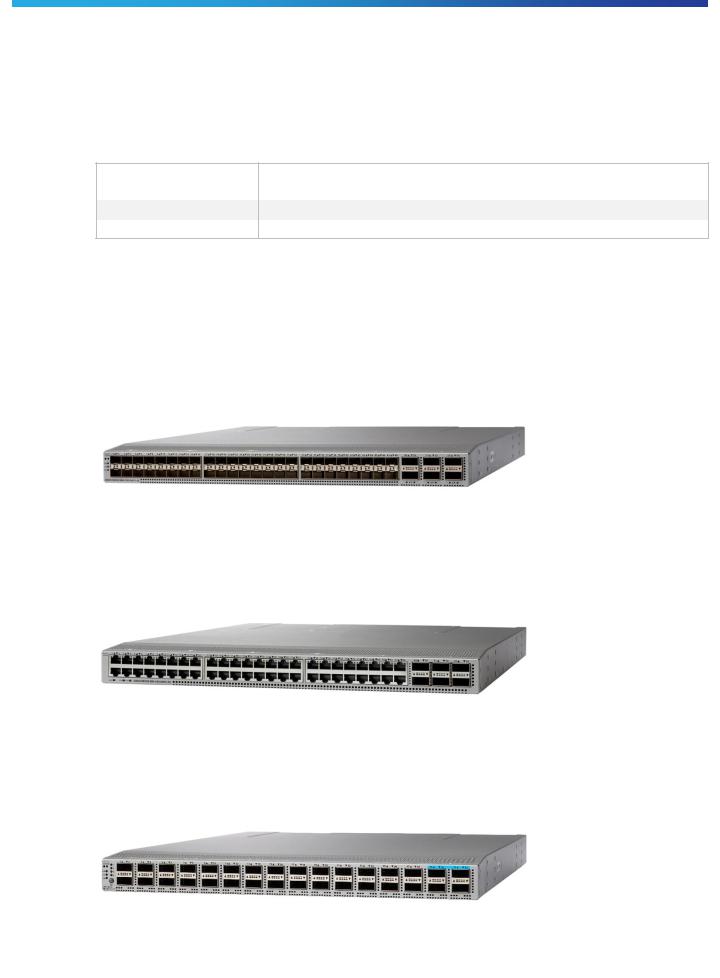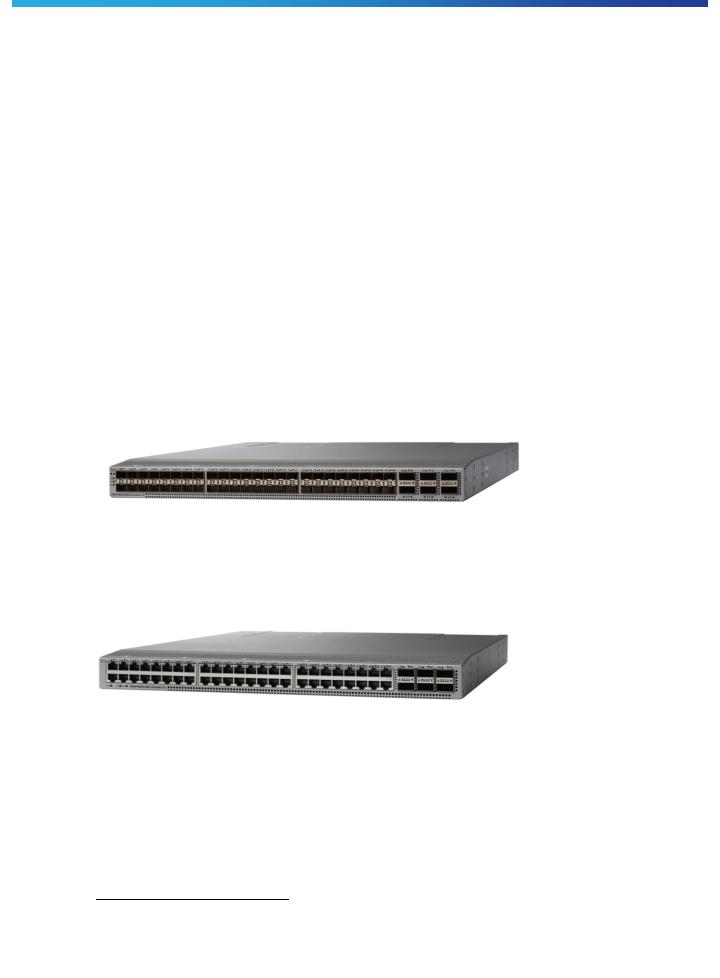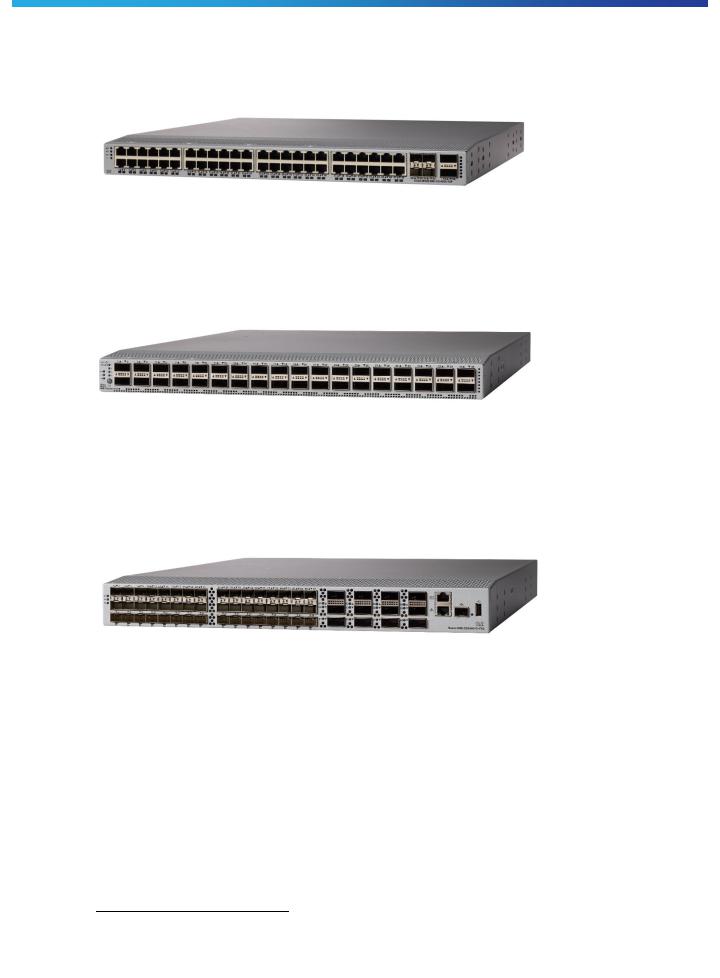Cisco Nexus 9300-EX, Nexus 9300-FX User Manual

Data Sheet
Cisco Nexus 9300-EX and 9300-FX Platform
Switches
Product overview
Based on Cisco Cloud Scale technology, the Cisco Nexus® 9300-EX and 9300-FX platforms are the next generation of fixed Cisco Nexus 9000 Series Switches. The new platforms support cost-effective cloud-scale deployments, an increased number of endpoints, and cloud services with wire-rate security and telemetry. The platforms are built on modern system architecture designed to provide high performance and meet the evolving needs of highly scalable data centers and growing enterprises.
Cisco Nexus 9300-EX and 9300-FX platform switches offer a variety of interface options to transparently migrate existing data centers from 100-Mbps, 1-Gbps, and 10-Gbps speeds to 25 Gbps at the server, and from 10and 40Gbps speeds to 50 and 100 Gbps at the aggregation layer. The platforms provide investment protection for customers, delivering large buffers, highly flexible Layer 2 and Layer 3 scalability, and performance to meet the changing needs of virtualized data centers and automated cloud environments.
The platform hardware is capable of collecting comprehensive Cisco Tetration Analytics™ telemetry information at line rate across all the ports without adding any latency to the packets or negatively affecting switch performance.
This telemetry information is exported every 100 milliseconds by default directly from the switch’s ApplicationSpecific Integrated Circuit (ASIC). This information consists of three types of data:
●Flow information: This information contains information about endpoints, protocols, ports, when the flow started, how long the flow was active, etc.
●Interpacket variation: This information captures any interpacket variations within the flow. Examples include variation in Time To Live (TTL), IP and TCP flags, payload length, etc.
●Context details: Context information is derived outside the packet header, including variation in buffer utilization, packet drops within a flow, association with tunnel endpoints, etc.
The Cisco Tetration Analytics platform consumes this telemetry data, and by using unsupervised machine learning and behavior analysis it can provide outstanding pervasive visibility across everything in your data center in real time. By using algorithmic approaches, the Cisco Tetration Analytics platform provides a deep application insights and interactions, enabling dramatically simplified operations, a zero-trust model, and migration of applications to any programmable infrastructure. To learn more, go to https://www.cisco.com/go/tetration.
Cisco provides two modes of operation for Cisco Nexus 9000 Series Switches. Organizations can use Cisco NX OS Software to deploy the switches in standard Cisco Nexus switch environments (NX-OS mode). Organizations also can use a hardware infrastructure that is ready to support the Cisco Application Centric Infrastructure (Cisco ACI™) platform to take full advantage of an automated, policy-based, systems-management approach (ACI mode).
© 2018 Cisco and/or its affiliates. All rights reserved. This document is Cisco Public Information. |
Page 1 of 13 |

Switch models
Table 1 summarizes the Cisco Nexus 9300-EX platform switch models.
Table 1. Cisco Nexus 9300-EX platform switches
Model |
Description |
|
|
Cisco Nexus 93180YC-EX Switch 48 x 1/10/25-Gbps fiber ports and 6 x 40/100-Gbps Quad Small Form-Factor Pluggable 28 (QSFP28) ports
Cisco Nexus 93108TC-EX Switch 48 x 100M/1/10GBASE-T ports and 6 x 40/100-Gbps QSFP28 ports
Cisco Nexus 93180LC-EX Switch Up to 32 x 40/50-Gbps QSFP+ ports OR 18 x 100-Gbps QSFP28 ports
The Cisco Nexus 93180YC-EX Switch (Figure 1) is a 1-Rack-Unit (1RU) switch with latency of less than 1 microsecond that supports 3.6 Terabits per second (Tbps) of bandwidth and over 2.6 billion packets per second (bpps). The 48 downlink ports on the 93180YC-EX can be configured to work as 1-, 10-, or 25-Gbps ports, offering deployment flexibility and investment protection. The uplink can support up to six 40and 100-Gbps ports, or a combination of 1-, 10-, 25-, 40-, 50-, and 100-Gbps connectivity, offering flexible migration options. The switch has FC-FEC enabled for 25Gbps, and supports upto 3m in DAC connectivity. Please check Cisco Optics Matrix for the most updated support.
Figure 1. Cisco Nexus 93180YC-EX Switch
The Cisco Nexus 93108TC-EX Switch (Figure 2) is a 1RU switch that supports 2.16 Tbps of bandwidth and over 1.5 bpps. The 48 10GBASE-T downlink ports on the 93108TC-EX can be configured to work as 100-Mbps, 1 Gbps, or 10-Gbps ports. The uplink can support up to six 40and 100-Gbps ports, or a combination of 1-, 10-, 25-, 40, 50-, and 100-Gbps connectivity, offering flexible migration options.
Figure 2. Cisco Nexus 93108TC-EX Switch
The Cisco Nexus 93180LC-EX Switch is the industry’s first 50-Gbps-capable 1RU switch that supports 3.6 Tbps of bandwidth and over 2.6 bpps across up to 32 fixed 40and 50-Gbps QSFP+ ports or up to 18 fixed 100-Gbps ports (Figure 3). The switch can support up to 72 10-Gbps ports using breakout cables. A variety of flexible port configurations are supported using templates.
Figure 3. Cisco Nexus 93180LC-EX Switch
© 2018 Cisco and/or its affiliates. All rights reserved. This document is Cisco Public Information. |
Page 2 of 13 |

Table 2 summarizes the Cisco Nexus 9300-FX platform switch models.
Table 2. |
Cisco Nexus 9300-FX platform switches |
|
|
|
|
Model |
|
Description |
|
|
|
Cisco Nexus 93180YC-FX Switch |
48 x 1/10/25-Gbps fiber ports and 6 x 40/100-Gbps QSFP28 ports |
|
|
|
|
Cisco Nexus 93108TC-FX Switch |
48 x 100M/1/10GBASE-T ports and 6 x 40/100-Gbps QSFP28 ports |
|
|
|
|
Cisco Nexus 9348GC-FXP |
48 x 100M/1G BASE-T ports, 4 x 10/25-Gbps SFP28 ports and 2 x 40/100-Gbps QSFP28 ports |
|
|
|
|
Cisco Nexus 9336C-FX2 |
36 x 40/100-Gbps QSFP28 ports |
|
|
|
|
Cisco Nexus 93240YC-FX2 |
48 x 1/10/25-Gbps fiber ports and 12 x 40/100-Gbps QSFP28 ports |
|
|
|
|
The Cisco Nexus 93180YC-FX Switch (Figure 4) is a 1RU switch with latency of less than 1 microsecond that supports 3.6 Tbps of bandwidth and 1.4 bpps. The 48 downlink ports on the 93180YC-FX can be configured to work as 1-, 10-, or 25-Gbps Ethernet or FCoE ports or as 16-, 32-Gbps Fibre Channel ports1, creating a point of convergence for primary storage, compute servers, and back-end storage resources at the top of rack.
The 6 uplinks ports can be configured as 40 and 100-Gbps Ethernet or FCoE ports, offering flexible migration options. All ports support wire-rate MACsec encryption2. The switch has FC-FEC and RS-FEC enabled for 25Gbps support.
Figure 4. Cisco Nexus 93180YC-FX Switch
The Cisco Nexus 93108TC-FX Switch (Figure 5) is a 1RU switch that supports 2.16 Tbps of bandwidth and over 850 mpps. The 48 10GBASE-T downlink ports on the 93108TC-FX can be configured to work as 100-Mbps, 1- Gbps, or 10-Gbps ports. The 6 uplinks ports can be configured as 40and 100-Gbps ports, offering flexible migration options.
Figure 5. Cisco Nexus 93108TC-FX Switch
The Cisco Nexus 9348GC-FXP Switch (Figure 6) is a 1RU switch that supports 696 Gbps of bandwidth and over 250 mpps. The 48 1GBASE-T downlink ports on the 9348GC-FXP can be configured to work as 100-Mbps, 1-Gbps ports. The 4 ports of SFP28 can be configured as 1/10/25-Gbps and the 2 ports of QSFP28 can be configured as 40and 100-Gbps ports. The Cisco Nexus 9348GC-FXP is ideal for big data customers that require a Gigabit Ethernet ToR switch with local switching.
1Capabilities to enable FC is on the software roadmap
2Capabilities to enable MACsec is on the software roadmap
© 2018 Cisco and/or its affiliates. All rights reserved. This document is Cisco Public Information. |
Page 3 of 13 |

Figure 6. Cisco Nexus 9348GC-FXP Switch
The Cisco Nexus 9336C-FX2 Switch (Figure 7) is a 1RU switch that supports 7.2 Tbps of bandwidth and over 2.8 bpps. The switch can be configured to work as 1/10/25/40/100-Gbps offering flexible options in a compact
form factor. All ports support wire-rate MACsec encryption3. Breakout is supported on all ports. Please see feature table below for more information.
Figure 7. Cisco Nexus 9336C-FX2 Switch
The Cisco Nexus 93240YC-FX2 Switch (Figure 8) supports 4.8 Tbps of bandwidth and over 1.8 bpps. The 48 ports of downlinks support 1/10/25-Gbps. The 12 uplinks ports can be configured as 40and 100-Gbps ports, offering flexible migration options. Breakout is not supported at FCS, but is on the roadmap. The switch is ideal for a nonoversubscribed solution in a compact form factor. The switch has FC-FEC and RS-FEC enabled for 25Gbps support.
Figure 8. Cisco Nexus 93240YC-FX2 Switch
Features and benefits
The Cisco Nexus 9300-EX and 9300-FX platforms provide the following features and benefits:
●High performance, scalability, flexibility, and security
◦The platform provides wire-rate Layer 2 and 3 switching on all ports.
◦Robust hardware system specifications feature 4-core and 6-core CPUs, a minimum of 24 GB of system memory (64 GB on 93180YC-FX model), and respectively 64-GB and 128-GB Solid-State Disk (SSD) drives on EX and FX models.
◦The 40-MB buffer supports highly scalable data centers and big data applications.
◦Flexible forwarding tables support up to 1 million shared entries on EX models and up to 2 million shared entries on FX models.
3 Capabilities to enable MACsec is on the software roadmap
© 2018 Cisco and/or its affiliates. All rights reserved. This document is Cisco Public Information. |
Page 4 of 13 |
